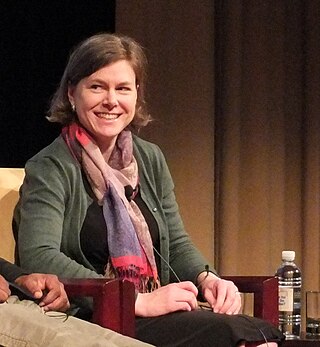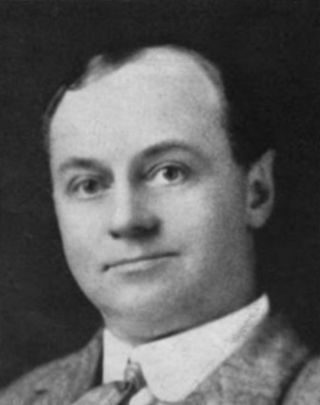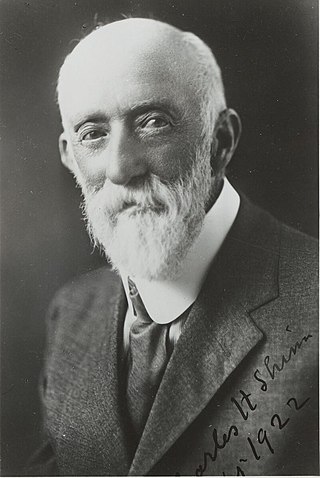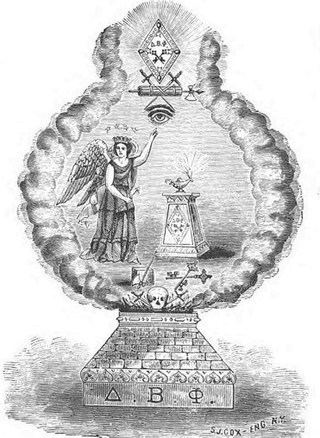
A cartoon is a type of visual art that is typically drawn, frequently animated, in an unrealistic or semi-realistic style. The specific meaning has evolved, but the modern usage usually refers to either: an image or series of images intended for satire, caricature, or humor; or a motion picture that relies on a sequence of illustrations for its animation. Someone who creates cartoons in the first sense is called a cartoonist, and in the second sense they are usually called an animator.

A political cartoon, a form of editorial cartoon, is a cartoon graphic with caricatures of public figures, expressing the artist's opinion. An artist who writes and draws such images is known as an editorial cartoonist. They typically combine artistic skill, hyperbole and satire in order to either question authority or draw attention to corruption, political violence and other social ills.

Harper's Weekly, A Journal of Civilization was an American political magazine based in New York City. Published by Harper & Brothers from 1857 until 1916, it featured foreign and domestic news, fiction, essays on many subjects, and humor, alongside illustrations. It carried extensive coverage of the American Civil War, including many illustrations of events from the war. During its most influential period, it was the forum of the political cartoonist Thomas Nast.
Physical Review is a peer-reviewed scientific journal established in 1893 by Edward Nichols. It publishes original research as well as scientific and literature reviews on all aspects of physics. It is published by the American Physical Society (APS). The journal is in its third series, and is split in several sub-journals each covering a particular field of physics. It has a sister journal, Physical Review Letters, which publishes shorter articles of broader interest.

Judge was a weekly satirical magazine published in the United States from 1881 to 1947. It was launched by artists who had seceded from its rival Puck. The founders included cartoonist James Albert Wales, dime novels publisher Frank Tousey and author George H. Jessop.

Jen Sorensen is an American cartoonist and illustrator who creates a weekly comic strip that often focuses on current events from a liberal perspective. Her work has appeared on the websites Daily Kos, Splinter, The Nib, Politico, AlterNet, and Truthout; and has appeared in Ms. Magazine, The Progressive, and The Nation. It also appears in over 20 alternative newsweeklies throughout America. In 2014 she became the first woman to win the Herblock Prize, and in 2017 she was named a Pulitzer Finalist in Editorial Cartooning.
Notable events of 2006 in comics. See also List of years in comics.

Standard Adding Machine Company was founded in the early 1890s in Illinois and was the first company to (successfully) release a 10-key adding machine. The machine was a breakthrough for its time because it dramatically modernized computing. Earlier key driven adding machines, like the comptometer, featured eight or more columns of nine keys, which made them cumbersome and costly and their operators prone to mistakes. The 10 keys were set on a single row.

Henry Haven Windsor, American author, magazine editor, and publisher, was the founder and first editor of Popular Mechanics. He was succeeded as editor by his son, Henry Haven Windsor, Jr (1898–1965). Windsor also published Cartoons Magazine from 1912 to 1922. Windsor was born in a log cabin in Mitchell, Iowa, the son of Rev. William D. D. Windsor and Harriet Butler (Holmes) Windsor. He attended Iowa College, graduating in 1884. On June 25, 1889, he married Lina B. Jackson in Marengo, Illinois.
Physikalische Zeitschrift was a German scientific journal of physics published from 1899 to 1945 by S. Hirzel Verlag. In 1924, it merged with Jahrbuch der Radioaktivität und Elektronik. From 1944 onwards, the journal published the Reichsberichte für Physik.
Comics journalism is a form of journalism that covers news or nonfiction events using the framework of comics, a combination of words and drawn images. Typically, sources are actual people featured in each story, and word balloons are actual quotes. The term "comics journalism" was coined by one of its most notable practitioners, Joe Sacco. Other terms for the practice include "graphic journalism," "comic strip journalism", "cartoon journalism", "cartoon reporting", "comics reportage", "journalistic comics", and "sketchbook reports".

The Ministry of Finance is a government ministry of the Republic of Liberia. As of 2018, the Liberian Finance Minister is Samuel D. Tweah, who was appointed in January 2018. The minister is appointed by the President of Liberia, with the consent of Senate of Liberia.

Charles Howard Shinn was a horticulturalist, author, inspector of California Experiment Stations, and forest ranger in California.

The Ottoman satirical magazine Karagöz was published from 1908 to 1955 twice a week in Istanbul. Its title has its origin in one of the protagonists of the traditional Ottoman shadow play, who acted together with his friend Hacivat. Karagöz was a common person, well known for his sharp tongue and clear criticism of politics and society. Both of them appear on each front page of the magazine.

Marjorie Benton Cooke was an American monologist, playwright, and novelist. A specialist in comic dramatic sketches and light romantic fiction, she also wrote and performed monologues on suffragist issues.

The Quiver (1861–1956) was a weekly magazine published by Cassell's and was "designed for the defence and promotion of biblical truth and the advance of religion in the homes of the people."

Delta Beta Phi (ΔΒΦ), also called Delta Beta Phi Society, was a small national men's fraternity founded at Cornell University in 1878. The national disbanded in 1882 but was briefly restored through the 1920s.

Frederick Ferdinand Moore was an early 20th century American novelist, short story writer, editor, publisher, soldier and war correspondent. His first novel The Devil's Admiral was inspired by his extensive travels as a sailor, a soldier serving in the US Army during the Philippine–American War, and later as a correspondent covering the Russo-Japanese War. As a captain in the US Army he was an intelligence officer in the American Expeditionary Force, Siberia, and was awarded the Order of the Rising Sun 5th Class by the Japanese government. He documented his first-hand experience witnessing the rise of the Bolsheviks in Siberia To-day, a text which remained as a key reference to the region for several decades after it was published.

Henry Middlebrook Crane was an American engineer and pioneer in the automobile industry. He was president of Crane Motor Car Company, vice-president and engineer of Simplex Automobile Company, and designed the Pontiac Six motor for General Motors.
Jessie Gillespie Willing was an American illustrator during the Golden Age of illustration. She was considered the foremost silhouette illustrator of her time, although she did traditional illustration as well. Willing illustrated for books and magazines including Life, The Ladies' Home Journal, Woman's Home Companion, Mother and Child, McClure's Magazine, Childhood Education, the Sunday Magazine, Association Men, Farm and Fireside, Every Week, Children: The Magazine for Parents, and the American Magazine. She is perhaps most well known for her work for the Girl Scouts.
















